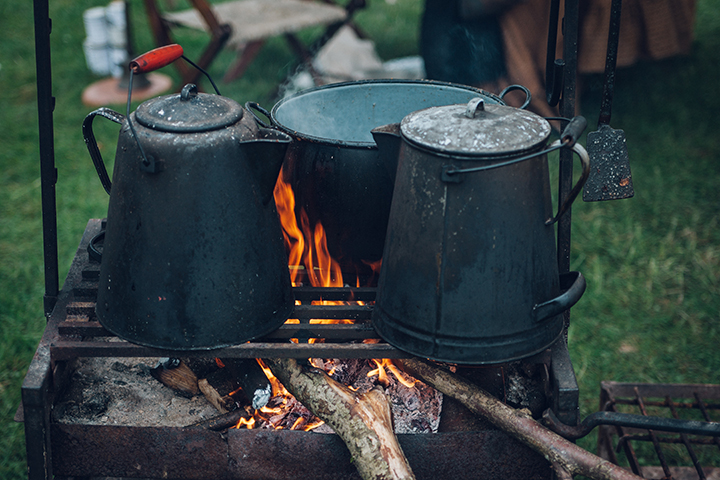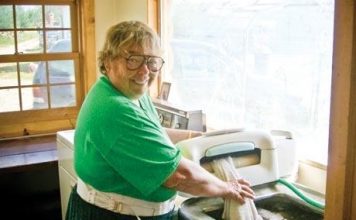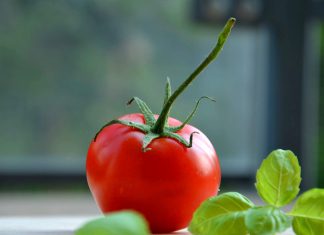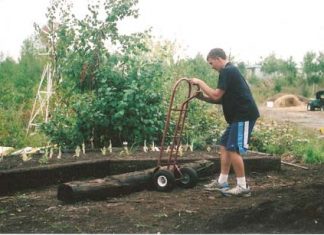| Issue #47 • September/October, 1997 |
Squatting heavily in dank basements, drafty attics, and dusty, cluttered garages, these three-legged hulks from a bygone era wait impatiently to release their treasures. Until then, they are pitted by time and tarnished by neglect. For those who will uncover the mystery, their gaping caverns can once again be brimming with magic.
From the birth of our nation, Dutch ovens have been an integral and versatile part of Americana. Sadly, today’s high-tech hustle-and-bustle lifestyle has all but forgotten the art of leather-glove cuisine. The coal-black cast iron ovens appear outdated, unfriendly, and forbidding. Interestingly however, with seven simple secrets revealed, the beginning camp cook and the consummate backyard chef can utilize these forgotten friends to produce a marvelous and unforgettable variety of succulent delicacies.

Dutch ovens owned by cooks who understand their subtleties are kept in places of honor, sanctuaries reserved specifically for them. On the other hand, ovens owned by cooks who can’t seem to keep the potatoes from burning to the bottom or who can never get the chicken to look anything but a pasty white, are quickly relegated to some obscure location where they will be out of the way. For the unsuccessful current user, the interested but uninitiated, or anyone who just wants to cook better, the seven secrets outlined below will provide a firm foundation for the creation and consumption of mouth-watering Dutch oven meals fit for even the most discriminating palates.
Secret 1: Choosing wisely
When deciding on a Dutch oven, there are a few important guidelines to keep in mind. A common question is, Should I buy cast iron or aluminum? Both have some advantages. Aluminum Dutch ovens weigh about one-third less than their cast iron counterparts. They require no curing, and, like the cast iron pots, can be used over open fires, buried underground, or used with coals or briquettes. However, aluminum Dutch ovens do not retain heat as well nor distribute it as evenly as cast iron. The flavoring of foods produced will also be different. Aluminum ovens sometimes give a chalky flavor to foods, whereas iron ovens give a smoked flavor to foods. Most Dutch oven aficionados use only cast iron ovens.
When buying a cast iron Dutch oven, whether new or used, look carefully at these five important areas:
1. Only buy Dutch ovens with legs. Some are manufactured with flat bottoms and are far more difficult to use. The three legs should be cleanly attached to the bottom of the oven, never cracked, bent, or broken off.
2. Check the fit of the lid. It should lie flush with the lip of the oven all the way around, with no significant gaps.
3. Check the casting, or thickness, of the metal, especially around the rim. There will be some inconsistencies. However, areas that are 15% (or more) thicker or thinner than the remaining areas will produce hot or cold spots during cooking and cooling. This variance in thickness will also make the oven much more likely to crack or warp.
4. Make sure the lid has a loop handle, cleanly attached to its center.
5. Check the bail (the wire handle) attached to the oven itself. It should be easily movable and strong enough to use for carrying or hanging a heavy pot full of stew without difficulty.
If these five areas pass inspection, you’ve got a good Dutch oven.
Another purchase consideration is the size of the oven. Dutch ovens range in size from 8 to 22 inches in diameter. The most commonly used are 10-inch, 12-inch, and 14-inch ovens. The larger ovens hold more if you’re cooking for large groups, but they are huge, heavy, and hard to handle If you only buy one oven to get started, pick a 12-inch. Later you can add a 10-, 14- or additional 12-inch ovens.
Secret 2: The miracle cure
Once you have an oven, it must be cured. This process will keep your oven from rusting and produce an interior coating that will prevent food from sticking. The process is very simple. If you have an old rusty oven, scrub it well and use a fine-grade sandpaper to clean up and expose the entire surface, inside and out. Once the metal is exposedor if you are curing a new ovenwash the entire oven well with hot soapy water. This will remove the waxy coating from a new oven and the fine metal dust remaining in an old reconditioned one.
Next, heat your Dutch oven, with the lid on, to about 200° in the oven in your home. (You can also do this in a fire, with coals or briquettes.) While the oven is hot, pour or drop in a small amount of oil, shortening, or lard, and while wearing oven mitts or heavy leather gloves, use a clean cotton cloth to wipe the entire surface well, inside and out, to coat it with the shortening, oil, or lard. When the oven is coated, heat it to 350° for an hour. If you do this in your house, expect some smoke. After an hour of heating, let the oven cool slowly. Force-cooling a cast iron oven by putting it in a freezer, snow bank, or outside during a cold rain, can crack or warp it.
Once you have your oven cured, it is ready for cooking. However, after each subsequent use and cleaning, you maintain and strengthen the cure by wiping a very light coat of oil, shortening, or lard over the dry, warm oven.
The proper cleaning of a Dutch oven is a favorite topic of many cast iron cooks. Some say that excess food must be burned off by turning the oven over in a fire, or by putting the lid on and heating the oven until the food residue inside is burned to a black crust or dust (like a self-cleaning household oven). Others claim it is a mortal sin to use any kind of soap when cleaning Dutch ovens. All, however, agree that you never scrape or scour a Dutch oven. Using metal utensils or wire scrubbers or brushes can remove the curing and allow food to stick in the exposed areas unless the oven is re-cured.

Most frequent Dutch oven users have found that wiping out excess food with a paper towel, then washing the pot with hot soapy water and a sponge will produce a clean and sanitary oven. Remember, after cleaning, be sure to dry the oven completely, then wipe a light coat of your chosen oil over the entire surface of your oven, inside and out, legs included, using a paper towel or cotton cloth. Soon your oven will have a beautiful dark brown or black coat that will be amazingly easy to keep clean.
If you use too much oil while curing or after cleaning your oven, it will become apparent the next time you use it. Each time you take out the oven, remove the lid and smell the inside. If it smells a little rancid, you used too much oil, but don’t worry. Just heat up the oven on your stove or over a fire to allow the oil to melt down and puddle in the bottom of the pot. Wipe out the old oil with a paper towel and you’re ready to go. There is no need to clean the oven again before using.
Secret 3: Power tools
You will need all the usual utensils required for cooking, such as spoons, forks, spatulas, etc. However, when you pick utensils to use with your Dutch ovens, choose items made of wood, plastic, or Teflon. Metal utensils tend to scrape off the curing when hungry eaters try to dig the last bite of food out of the oven. If areas do get scraped to the bare metal of the oven, you’ll need to re-cure it.
In addition to the utensils you are familiar with, there are other tools unique to Dutch ovens which will make your efforts safer, easier, and more successful.
1. You will need a pair of loose-fitting leather gloves long enough to cover your wrists. When leather gloves get hot, loose ones can be flipped off easily and quickly. Tight hot gloves will stick and burn you. Some people prefer welding gloves (gauntlets), but any good thick leather gloves should do fine. Wear these gloves when working with your ovens. They will prevent numerous painful burns, dropped ovens, and ruined meals.
2. Another tool you will need is a lid lifter. There are a number of lid lifter designs to choose from. The most typical is a wire-handled hook. Many of these hooks have a small bar welded horizontally a short distance up the handle from the curve. This is to keep the lid from tilting from side to side while being lifted. Hook lifters can be very ornate or simple hay-hook-like designs. Probably the surest lid lifter is a more recent design which combines the hook with a three-legged brace. The three legs fit flush against the top of the lid, and the hook goes down the middle of the legs and under the lid handle. With this type of lifter, the hook is pulled up to tighten the lid against the three legs of the brace. This design is steady and excellent for keeping coals and ashes on the lid from accidentally becoming additional garnish for the dish being prepared.
3. Lid holders are also a necessity. This tool may be anything from a clean brick to a three- or four-legged wire rack. It is used to keep hot lids off tables and counter tops or out of the dirt when the cook is adding spices or checking the progress of meals cooking.
4. Long-handled tongs are an invaluable addition to your Dutch oven tools. Even a cheap stainless steel pair will last indefinitely. Tongs are used to place, add, or remove coals as necessary. Attempting to position coals with sticks, pliers, etc., often results in poor placement, burned hands, and generally miserable experiences.
5. A small shovel is also important. This small tool, a garden shovel or fireplace shovel, is used for moving coals from a fire, digging a long-cook pit, or burying excess extinguished charcoal.
6. The last special tool you will want to consider is a whisk broom. The broom is used to brush the dirt, ashes, etc., off the lid and side of your oven in preparation for serving. This makes the possibility of ash-flavored beans remote and cleans up the ovens nicely to prevent carrying dirt or charcoal into your camper, cabin, tent, or kitchen.
Secret 4: A fire in the belly
Here’s a secret that even most seasoned outdoor cooks don’t know: You can prevent burned bottoms, raw tops, and dried-out foods by using properly sized and spaced coals to control the interior oven temperature. Virtually all baked goods can be baked successfully at 350°, which is the ideal temperature for a Dutch oven. To establish and maintain this temperature, the first thing to remember is to use coals from a fire that are roughly the same size as charcoal briquettes.
Or, for more consistency, use briquettes. Charcoal briquettes will burn longer and more evenly than coals from a fire. Use the best briquettes you can afford. There is a difference in quality, and the more expensive brands are generally worth the additional cost.
The number and placement of the coals on and under your oven is critical.The optimal number of coals used for any oven is based on its diameter. For example, if you are using a 12-inch oven, you will need two coals per inch, a total of 24. More coals will likely burn your food and less may necessitate too long a cooking period. To determine how many coals go under and how many go on top, remember the magic number 2:
· 2 coals per inch of oven diameter
· place 2 more coals than the oven size on the lid, and
· place 2 less than the oven size under it.
Example: For a 12-inch oven, 12 – 2 = 10 coals under the oven, and 12+2=14 coals go on the lid, for a total of 24. The same formula applies to all ovens. A 10-inch oven should have 8 coals underneath and 12 coals on the lid. A 14-inch oven should have 12 coals underneath and 16 coals on the lid.
The placement of the coals is also an important part of proper heat regulation. The proper layout for coals or briquettes under the oven is circular. Coals should be approximately one inch apart in a circle under the oven. Never place coals directly under the center of the oven. If you do, you will create a hot spot and burn whatever you are cooking. By placing the coals in a circle, the natural conductivity of the oven will distribute the heat evenly and effectively.

The coals on the lid of the oven should also be placed evenly in a circle along the flange of the outer lid. However, four of the coals should be placed toward the center of the lid, two on either side of the handle. This coal placement will produce an even, consistent temperature within the oven of approximately 350° and maintain that heat for up to two hours.
In the event that you need to generate a higher temperature inside your oven, cheat up the coals. Additional coals placed two at a time, one on the lid and one under the oven, will add another 50°. Two additional coals top and bottom would bring your oven’s temperature up to 450°. It is extremely rare to need a temperature of 450°, and you should never need one higher than that.
Secret 5: A cut above
Meats prepared in a Dutch oven are delectable. They have a flavor and aroma you will never duplicate using any other cooking method. While the taste is always exquisite, some Dutch oven users have difficulty producing a visually appealing meat from inside the steamy oven. The secret is simple: regardless of the spice and flavorings you use on any meat or poultry, always brown the meat first.
To brown the meat, place some oil, bacon, or any fatty item in the hot oven to produce a good covering of oil on the bottom, heat the oven, then put the meat you want to cook in the oven and sear or brown it well. This will seal in natural juices and provide the outer texture and color more typical of grilled or fried meats. Once the meat is well browned on all sides, drain off any leftover fat drippings, add whatever seasonings you like, put on the lid, and cook the meat for 30 to 35 minutes per pound of beef, pork, or lamb, or 25 to 30 minutes per pound of poultry.
Secret 6: Garden pride
Garden vegetables are a magnificent addition to any Dutch oven dinner. Most Dutch oven vegetables are prepared in a sauce of some type, but they may be steamed or boiled as you would on a traditional stove. However, if you choose to bake or roast Dutch oven vegetables, they should cook for approximately three minutes per inch of oven diameter. A l0-inch oven full of squash should cook for about 30 minutes, a 12-inch oven full for 36 minutes. Vegetables to be cooked in sauces, such as sour cream potatoes, broccoli in cheese sauce, or new peas and potatoes in white sauce, should be brought to a rapid boil first, the water discarded, the sauces added, then baked for the proper time noted for other vegetables.
Secret 7: If you knead the dough
Good Dutch oven breads seem to be a rarity. However, marvelous corn breads, biscuits, rolls, and sourdough loaves are surprisingly easy to perfect in the old black pot. The larger the oven the better when it comes to cooking breads. A 14-inch oven serves nicely to produce three loaves of bread or up to three dozen rolls or biscuits. To successfully brown breads, however, you must alter the cooking process for the last five to eight minutes of the traditional 25-30 minute, 350° baking time.
First, put a light coat of oil on the interior of a cool oven (including the lid), and let the rolls or bread complete their final rise in the oven prior to applying the coals. Second, place the oven on the coals with the proper number of coals on top as noted earlier. (Remember: no coals directly under the center of the oven.) Third, when there are five to eight minutes left in the cooking time, lift the lid, lightly brush the tops of the breads with butter, replace the lid, then take all the coals from under the oven and distribute them evenly on the top. With all the heat now on the lid, check the bread every couple of minutes until you think it looks perfect. After brushing the coals and ashes from the lid, remove it, tilt the oven over a bread board, and your perfect bread will gently fall out.
Now that you know the seven secrets, here is a trio of fabulous tried-and-true recipes you can easily make with your old, new, or reincarnated Dutch oven.
Prairie chicken
Using the correct number of coals under the oven, brown both sides of enough clean, uncoated chicken pieces to cover the bottom in a hot Dutch oven with a bubbling ¼ inch of oil. When the chicken is browned to your liking, remove the excess oil from the oven and discard. Season the chicken generously with the following pre-mixed coating:
2 Tablespoons each, parsley flakes
& thyme
1 Tablespoon each, marjoram, oregano, celery salt, &
rosemary
1 teaspoon each, garlic salt, onion salt, ginger, ground
black pepper, sage, & paprika
Put lid on oven, arrange coals as noted earlier (top and bottom) and cook for 45 minutes to one hour.
Italian zucchini
Coat and marinate zucchini or summer squash (one per person) for 30 minutes in a mixture of ½ olive oil and ½ lemon juice (A half cup of each will coat enough zucchini for 20 people.) Place one layer of the marinated vegetables in the bottom of the Dutch oven. (A 10-inch oven works great for up to 15 people.) Sprinkle salt, pepper, and a good coating of grated Romano cheese over the layer, then repeat the process, layer upon layer, until all the zucchini is used or until the oven is almost full. Sprinkle extra Romano cheese on the top layer. Place the lid on the oven and cook as noted earlier with the proper number and placement of coals. Cook for 30 to 35 minutes. This is a marvelous tart and tasty vegetable treat, guaranteed.
Trailside beans
½ pound bacon, sliced in small pieces
½ pound ground beef
½ diced onion1 diced red bell pepper
1 diced green bell pepper
Two 33-oz. cans of pork and beans
½ cup brown sugar
¼ cup of Worcestershire sauce
2 Tablespoons of white vinegar
Cook bacon and ground beef well in a 12-inch Dutch oven. Use 24 coals all on the bottom to start, then separate and place the coals as noted earlier during the baking stage. Before removing excess oil, sauté diced onion, diced red bell pepper, and diced green bell pepper with the meats until the onions and peppers are soft. Drain off excess oil. Add pork and beans, brown sugar, Worcestershire sauce, and white vinegar. Stir well, place lid on oven, and cook with repositioned coals for 90 to 120 minutes.
Check for moisture content every 15 to 20 minutes. (Some ovens allow too much moisture to escape.) If there is not a soupy layer of liquid covering the beans, add water, a little at a time, and stir to maintain the moisture content.
Eat this with hot biscuits and jam, and you’ll understand why cowboys always looked so happy on those long, hard, dusty cattle drives.














